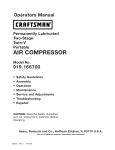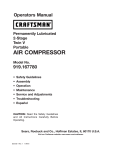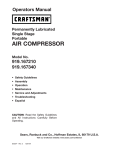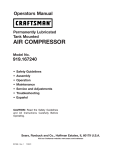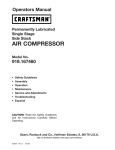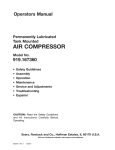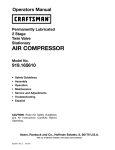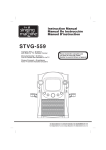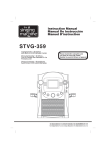Download Craftsman 919.152350 Troubleshooting guide
Transcript
Owners Manual Permanently Lubricated Compact AIR COMPRESSOR Model No. 919.152350 CAUTION: Read the Safety Guidelines and All Instructions Carefully Before Operating. • • • • • • • • Safety Guidelines Assembly Operation Maintenance Service and Adjustments Troubleshooting Repair Parts Español Sears, Roebuck and Co., Hoffman Estates, IL 60179 U.S.A. Visit our Craftsman website: www.sears.com/craftsman A08593 Rev. 0 11/4/04 TABLE OF CONTENTS SPECIFICATION CHART . . . . . . . . . . . . . . . . . . . .2 Description of Operation . . . . . . . . . . . . . . . . . .9 WARRANTY . . . . . . . . . . . . . . . . . . . . . . . . . . . . . .2 How to Use Your Unit . . . . . . . . . . . . . . . . . . .10 SAFETY GUIDELINES . . . . . . . . . . . . . . . . . . . .3-6 How to Stop . . . . . . . . . . . . . . . . . . . . . . . . . .10 GLOSSARY . . . . . . . . . . . . . . . . . . . . . . . . . . . . . . .7 To Use Quick Connect Sockets and Plugs . .10 ACCESSORIES . . . . . . . . . . . . . . . . . . . . . . . . . . .7 To Use Female Tire Chuck . . . . . . . . . . . . . . .10 ASSEMBLY . . . . . . . . . . . . . . . . . . . . . . . . . . . . . . .7 To Use Blow Gun . . . . . . . . . . . . . . . . . . . . . .10 Contents of Carton . . . . . . . . . . . . . . . . . . . . . .7 Before Starting . . . . . . . . . . . . . . . . . . . . . . . .10 To Remove Air compressor From Carton . . . . .7 How to Start . . . . . . . . . . . . . . . . . . . . . . . . . .10 INSTALLATION . . . . . . . . . . . . . . . . . . . . . . . . . . . .8 SERVICE AND ADJUSTMENTS . . . . . . . . . . . . .11 Location of Air Compressor . . . . . . . . . . . . . . .8 Air Hose Replacement . . . . . . . . . . . . . . . . . .11 Grounding Instructions . . . . . . . . . . . . . . . . . . .8 STORAGE . . . . . . . . . . . . . . . . . . . . . . . . . . . . . . .11 Extension Cords . . . . . . . . . . . . . . . . . . . . . . . .8 TROUBLESHOOTING GUIDE . . . . . . . . . . . . . . .12 Voltage and Circuit Protection . . . . . . . . . . . . .8 REPAIR PARTS . . . . . . . . . . . . . . . . . . . . . . . . . . .13 OPERATING PROCEDURES . . . . . . . . . . . . . .9-10 ESPAÑOL . . . . . . . . . . . . . . . . . . . . . . . . . . . . . . .15 Know Your Air Compressor . . . . . . . . . . . . . . .9 HOW TO ORDER REPAIR PARTS . . . . .back cover SPECIFICATION CHART Model No. Running Horsepower Displacement CFM Bore Stroke Voltage-Single Phase Minimum Branch Circuit Requirement Fuse Type SCFM @ 40 psig SCFM @ 90 psig 919-152350 1 4.8 1-7/8" 1-1/4" 120 10 amps Time Delay 3.7 2.6 FULL ONE YEAR WARRANTY AIR COMPRESSOR If this air compressor fails due to a defect in material or workmanship within one year from the date of purchase, RETURN IT TO THE NEAREST SEARS REPAIR CENTER THROUGHOUT THE UNITED STATES AND SEARS WILL REPAIR IT, FREE OF CHARGE. If purchased from Orchard Supply Hardware, return to the nearest Orchard Store and Orchard will repair it, free of charge. If this air compressor is used for commercial or rental purposes, the warranty will apply for ninety days from the date of purchase. This warranty gives you specific legal rights and you may have other rights which vary from state to state. Sears, Roebuck and Co., Dept. 817WA, Hoffman Estates, Il 60179 A08593 2 - ENG SAFETY GUIDELINES - DEFINITIONS SAFETY and PREVENTING EQUIPMENT PROBLEMS. To help you recognize this information, we use the symbols below. Please read the manual and pay attention to these sections. Indicates an imminently hazardous situation which, if not avoided, will result in death or serious injury. Indicates a potentially hazardous situation which, if not avoided, may result in minor or moderate injury. Indicates a potentially hazardous situation which, if not avoided, could result in death or serious injury. Used without the safety alert symbol indicates a potentially hazardous situation which, if not avoided, may result in property damage. IMPORTANT SAFETY INSTRUCTIONS SAVE THESE INSTRUCTIONS IMPROPER OPERATION OR MAINTENANCE OF THIS PRODUCT COULD RESULT IN SERIOUS INJURY AND PROPERTY DAMAGE. READ AND UNDERSTAND ALL WARNINGS AND OPERATING INSTRUCTIONS BEFORE USING THIS EQUIPMENT. RISK OF EXPLOSION OR FIRE HOW TO PREVENT IT WHAT CAN HAPPEN IT IS NORMAL FOR ELECTRICAL CONTACTS WITHIN THE MOTOR AND PRESSURE SWITCH TO SPARK. ALWAYS OPERATE THE COMPRESSOR IN A WELL VENTILATED AREA FREE OF COMBUSTIBLE MATERIALS, GASOLINE OR SOLVENT VAPORS. IF ELECTRICAL SPARKS FROM COMPRESSOR COME INTO CONTACT WITH FLAMMABLE VAPORS, THEY MAY IGNITE, CAUSING FIRE OR EXPLOSION. IF SPRAYING FLAMMABLE MATERIALS, LOCATE COMPRESSOR AT LEAST 20 FEET AWAY FROM SPRAY AREA. AN ADDITIONAL LENGTH OF HOSE MAY BE REQUIRED. STORE FLAMMABLE MATERIALS IN A SECURE LOCATION AWAY FROM COMPRESSOR. RESTRICTING ANY OF THE COMPRESSOR VENTILATION OPENINGS WILL CAUSE SERIOUS OVERHEATING AND COULD CAUSE FIRE. NEVER PLACE OBJECTS AGAINST OR ON TOP OF COMPRESSOR. OPERATE COMPRESSOR IN AN OPEN AREA AT LEAST 12 INCHES AWAY FROM ANY WALL OR OBSTRUCTION THAT WOULD RESTRICT THE FLOW OF FRESH AIR TO THE VENTILATION OPENINGS. OPERATE COMPRESSOR IN A CLEAN, DRY, WELL VENTILATED AREA. DO NOT OPERATE UNIT INDOORS OR IN ANY CONFINED AREA. UNATTENDED OPERATION OF THIS PRODUCT COULD RESULT IN PERSONAL INJURY OR PROPERTY DAMAGE. ALWAYS REMAIN IN ATTENDANCE WITH THE PRODUCT WHEN IT IS OPERATING. 3 - ENG A08593 HAZARD RISK OF BURSTING AIR TANK: THE FOLLOWING CONDITIONS COULD LEAD TO A WEAKENING OF THE TANK, AND RESULT IN A VIOLENT TANK EXPLOSION AND COULD CAUSE PROPERTY DAMAGE OR SERIOUS INJURY. WHAT CAN HAPPEN HOW TO PREVENT IT 1. FAILURE TO PROPERLY DRAIN CONDENSED WATER FROM THE TANK, CAUSING RUST AND THINNING OF THE STEEL TANK. DRAIN TANK DAILY OR AFTER EACH USE. IF TANK DEVELOPS A LEAK, REPLACE IT IMMEDIATELY WITH A NEW TANK OR REPLACE THE ENTIRE COMPRESSOR. 2. MODIFICATIONS OR ATTEMPTED REPAIRS TO THE TANK. NEVER DRILL INTO, WELD, OR MAKE ANY MODIFICATIONS TO THE TANK OR ITS ATTACHMENTS. 3. UNAUTHORIZED MODIFICATIONS TO THE UNLOADER VALVE, SAFETY VALVE, OR ANY OTHER COMPONENTS WHICH CONTROL TANK PRESSURE. THE TANK IS DESIGNED TO WITHSTAND SPECIFIC OPERATING PRESSURES. NEVER MAKE ADJUSTMENTS OR PARTS SUBSTITUTIONS TO ALTER THE FACTORY SET OPERATING PRESSURES. 4. EXCESSIVE VIBRATION CAN WEAKEN THE AIR TANK AND CAUSE RUPTURE OR EXPLOSION. ATTACHMENTS & ACCESSORIES: EXCEEDING THE PRESSURE RATING OF AIR TOOLS, SPRAY GUNS, AIR OPERATED ACCESSORIES, TIRES AND OTHER INFLATABLES CAN CAUSE THEM TO EXPLODE OR FLY APART, AND COULD RESULT IN SERIOUS INJURY. FOR ESSENTIAL CONTROL OF AIR PRESSURE, YOU MUST INSTALL A PRESSURE REGULATOR AND PRESSURE GAUGE TO THE AIR OUTLET OF YOUR COMPRESSOR. FOLLOW THE EQUIPMENT MANUFACTURERS RECOMMENDATION AND NEVER EXCEED THE MAXIMUM ALLOWABLE PRESSURE RATING OF ATTACHMENTS. NEVER USE COMPRESSOR TO INFLATE SMALL LOWPRESSURE OBJECTS SUCH AS CHILDREN’S TOYS, FOOTBALLS, BASKETBALLS, ETC. RISK FROM FLYING OBJECTS WHAT CAN HAPPEN HOW TO PREVENT IT THE COMPRESSED AIR STREAM CAN CAUSE SOFT TISSUE DAMAGE TO EXPOSED SKIN AND CAN PROPEL DIRT, CHIPS, LOOSE PARTICLES AND SMALL OBJECTS AT HIGH SPEED, RESULTING IN PROPERTY DAMAGE OR PERSONAL INJURY. ALWAYS WEAR ANSI Z87.1 APPROVED SAFETY GLASSES WITH SIDE SHIELDS WHEN USING THE COMPRESSOR. NEVER POINT ANY NOZZLE OR SPRAYER TOWARD ANY PART OF THE BODY OR AT OTHER PEOPLE OR ANIMALS. ALWAYS TURN THE COMPRESSOR OFF AND BLEED PRESSURE FROM THE AIR HOSE AND TANK BEFORE ATTEMPTING MAINTENANCE, ATTACHING TOOLS OR ACCESSORIES. A08593 4 - ENG HAZARD RISK OF ELECTRICAL SHOCK WHAT CAN HAPPEN HOW TO PREVENT IT YOUR AIR COMPRESSOR IS POWERED BY ELECTRICITY. LIKE ANY OTHER ELECTRICALLY POWERED DEVICE, IF IT IS NOT USED PROPERLY IT MAY CAUSE ELECTRIC SHOCK. NEVER OPERATE THE COMPRESSOR OUTDOORS WHEN IT IS RAINING OR IN WET CONDITIONS. REPAIRS ATTEMPTED BY UNQUALIFIED PERSONNEL CAN RESULT IN SERIOUS INJURY OR DEATH BY ELECTROCUTION. ANY ELECTRICAL WIRING OR REPAIRS REQUIRED ON THIS PRODUCT SHOULD BE PERFORMED BY AUTHORIZED SERVICE CENTER PERSONNEL IN ACCORDANCE WITH NATIONAL AND LOCAL ELECTRICAL CODES. ELECTRICAL GROUNDING: FAILURE TO PROVIDE ADEQUATE GROUNDING TO THIS PRODUCT COULD RESULT IN SERIOUS INJURY OR DEATH FROM ELECTROCUTION. SEE GROUNDING INSTRUCTIONS. MAKE CERTAIN THAT THE ELECTRICAL CIRCUIT TO WHICH THE COMPRESSOR IS CONNECTED PROVIDES PROPER ELECTRICAL GROUNDING, CORRECT VOLTAGE AND ADEQUATE FUSE PROTECTION. NEVER OPERATE COMPRESSOR WITH PROTECTIVCOVERS REMOVED OR DAMAGED. RISK TO BREATHING HOW TO PREVENT IT WHAT CAN HAPPEN THE COMPRESSED AIR DIRECTLY FROM YOUR COMPRESSOR IS NOT SAFE FOR BREATHING. THE AIR STREAM MAY CONTAIN CARBON MONOXIDE, TOXIC VAPORS, OR SOLID PARTICLES FROM THE TANK. BREATHING THESE CONTAMINANTS CAN CAUSE SERIOUS INJURY OR DEATH. AIR OBTAINED DIRECTLY FROM THE COMPRESSOR SHOULD NEVER BE USED TO SUPPLY AIR FOR HUMAN CONSUMPTION. IN ORDER TO USE AIR PRODUCED BY THIS COMPRESSOR FOR BREATHING, SUITABLE FILTERS AND IN-LINE SAFETY EQUIPMENT MUST BE PROPERLY INSTALLED. IN-LINE FILTERS AND SAFETY EQUIPMENT USED IN CONJUNCTION WITH THE COMPRESSOR MUST BE CAPABLE OF TREATING AIR TO ALL APPLICABLE LOCAL AND FEDERAL CODES PRIOR TO HUMAN CONSUMPTION. SPRAYED MATERIALS SUCH AS PAINT, PAINT SOLVENTS, PAINT REMOVER, INSECTICIDES, WEED KILLERS, CONTAIN HARMFUL VAPORS AND POISONS. WORK IN AN AREA WITH GOOD CROSS-VENTILATION. READ AND FOLLOW THE SAFETY INSTRUCTIONS PROVIDED ON THE LABEL OR SAFETY DATA SHEETS FOR THE MATERIAL YOU ARE SPRAYING. USE A NIOSH/MSHA APPROVED RESPIRATOR DESIGNED FOR USE WITH YOUR SPECIFIC APPLICATION. 5 - ENG A08593 HAZARD RISK OF BURNS WHAT CAN HAPPEN HOW TO PREVENT IT TOUCHING EXPOSED METAL SUCH AS THE COMPRESSOR HEAD OR OUTLET TUBES, CAN RESULT IN SERIOUS BURNS. NEVER TOUCH ANY EXPOSED METAL PARTS ON COMPRESSOR DURING OR IMMEDIATELY AFTER OPERATION. COMPRESSOR WILL REMAIN HOT FOR SEVERAL MINUTES AFTER OPERATION. DO NOT REACH AROUND PROTECTIVE SHROUDS OR ATTEMPT MAINTENANCE UNTIL UNIT HAS BEEN ALLOWED TO COOL. RISK FROM MOVING PARTS WHAT CAN HAPPEN HOW TO PREVENT IT MOVING PARTS SUCH AS THE PULLEY, FLYWHEEL AND BELT CAN CAUSE SERIOUS INJURY IF THEY COME INTO CONTACT WITH YOU OR YOUR CLOTHING. NEVER OPERATE THE COMPRESSOR WITH GUARDS OR COVERS WHICH ARE DAMAGED OR REMOVED. ATTEMPTING TO OPERATE COMPRESSOR WITH DAMAGED OR MISSING PARTS OR ATTEMPTING TO REPAIR COMPRESSOR WITH PROTECTIVE SHROUDS REMOVED CAN EXPOSE YOU TO MOVING PARTS AND CAN RESULT IN SERIOUS INJURY. ANY REPAIRS REQUIRED ON THIS PRODUCT SHOULD BE PERFORMED BY AUTHORIZED SERVICE CENTER PERSONNEL. RISK OF FALLING WHAT CAN HAPPEN HOW TO PREVENT IT A PORTABLE COMPRESSOR CAN FALL FROM A TABLE, WORKBENCH OR ROOF CAUSING DAMAGE TO THE COMPRESSOR AND COULD RESULT IN SERIOUS INJURY OR DEATH TO THE OPERATOR. ALWAYS OPERATE COMPRESSOR IN A STABLE SECURE POSITION TO PREVENT ACCIDENTAL MOVEMENT OF THE UNIT. NEVER OPERATE COMPRESSOR ON A ROOF OR OTHER ELEVATED POSITION. USE ADDITIONAL AIR HOSE TO REACH HIGH LOCATIONS. RISK OF PROPERTY DAMAGE WHEN TRANSPORTING COMPRESSOR (Fire, Inhalation, Damage to Vehicle Surfaces) For units requiring oil in pump or gasoline engines WHAT CAN HAPPEN HOW TO PREVENT IT OIL CAN LEAK OR SPILL AND COULD RESULT IN FIRE OR BREATHING HAZARD, SERIOUS INJURY OR DEATH CAN RESULT. OIL LEAKS WILL DAMAGE CARPET, PAINT OR OTHER SURFACES IN VEHICLES OR TRAILERS. ALWAYS PLACE COMPRESSOR ON A PROTECTIVE MAT WHEN TRANSPORTING TO PROTECT AGAINST DAMAGE TO VEHICLE FROM LEAKS. REMOVE COMPRESSOR FROM VEHICLE IMMEDIATELY UPON ARRIVAL AT YOUR DESTINATION. A08593 6 - ENG GLOSSARY Become familiar with these terms before operating the unit. CFM: Cubic feet per minute. SCFM: Standard cubic feet per minute; a unit of measure of air delivery. PSIG: Pounds per square inch gauge; a unit of measure of pressure. Code Certification: Products that bear one or more of the following marks: UL, CUL, ETL, CETL, have been evaluated by OSHA certified independent safety laboratories and meet the applicable Underwriters Laboratories Standards for Safety. Branch Circuit: Circuit carrying electricity from electrical panel to outlet ACCESSORIES This unit is capable of powering the following Accessories. The accessories are available through the current Power and Hand Tool Catalog or full-line Sears stores. Carpentry Tools Accessories Finishing Nailer / Stapler Quick Connect Sets (various sizes) Specialty Tools Air Brush Inflating/Blow Gun Grease Gun Caulk Gun ASSEMBLY Contents of Carton 1. Air Compressor with hose and pressure adjustment valve (qty 1) 1 2. Quick Connect Coupling (qty 1) 3. Quick Connect Studs (qty 2) 4. Thread Sealant Tape (qty 1) 5 4 5. Female Tire Chuck (qty 1) 6 6. Blow Gun (qty 1) 2 7. Safety Nozzle (qty 1) 3 8. Blow Gun Adapter (qty 1) 10 9. Inflating Needle (qty 1) 7 9 10. Tapered Inflator (qty 1) 8 To Remove Air Compressor From Carton 1. Grasp handle and lift the air compressor out of the carton. 2. Remove all packaging from air compressor and discard. 7 - ENG A08593 INSTALLATION IMPROPER GROUNDING CAN RESULT IN ELEC- HOW TO SET UP YOUR UNIT Location of the Air Compressor TRICAL SHOCK. Locate the air compressor in a clean, dry and well ventilated area. The air compressor pump and shroud are designed to allow for proper cooling. The ventilation openings on the compressor are necessary to maintain proper operating temperature. Do not place rags or other containers on or near these openings. Do not modify the plug provided. If it does not fit the available outlet, a correct outlet should be installed by a qualified electrician. Repairs to the cord set or plug MUST be made by a qualified electrician. Extension Cords GROUNDING INSTRUCTIONS Use extra air hose instead of an extension cord to avoid voltage drop and power loss to the motor, and to prevent overheating. RISK OF ELECTRICAL SHOCK. In the event of a short circuit, grounding reduces the risk of shock by providing an escape wire for the electric current. This air compressor must be properly grounded. If an extension cord must be used, be sure it is: The portable air compressor is equipped with a cord having a grounding wire with an appropriate grounding plug (see following illustrations). The plug must be used with an outlet that has been installed and grounded in accordance with all local codes and ordinances. 1. The cord set and plug with this unit contains a grounding pin. This plug MUST be used with a grounded outlet. • a 3-wire extension cord that has a 3-blade grounding plug, and a 3-slot receptacle that will accept the plug on the product • in good condition • no longer than 50 feet • 14 gauge (AWG) or larger. (Wire size increases as gauge number decreases. 12 AWG, 10 AWG, and 8 AWG may also be used. DO NOT USE 16 OR 18 AWG.) Voltage and Circuit Protection IMPORTANT: The outlet being used must be installed and grounded in accordance with all local codes and ordinances. 2. Make sure the outlet being used has the same configuration as the grounded plug. DO NOT USE AN ADAPTER. See figure. Refer to the Parts Manual for the voltage and minimum branch circuit requirements. Certain air compressors can be operated on a 15 amp circuit if the following conditions are met. 1. Voltage supply through branch circuit is 15 amps. 2. Circuit is not used to supply any other electrical needs (lights, appliances, etc.). 3. Extension cords comply with specifications. Plug 4. Circuit is equipped with a 15 amp circuit breaker or 15 amp time delay fuse. NOTE: If compressor is connected to a circuit protected by fuses, use only time delay fuses marked “D”. Grounded Outlets Grounding Pin 3. Inspect the plug and cord before each use. Do not use if there are signs of damage. 4. If these grounding instructions are not completely understood, or if in doubt as to whether the compressor is properly grounded, have the installation checked by a qualified electrician. A08593 If any of the above conditions cannot be met, or if operation of the compressor repeatedly causes interruption of the power, it may be necessary to operate it from a 20 amp circuit. It is not necessary to change the cord set. 8 - ENG OPERATION Know Your Air Compressor READ THIS OWNER’S MANUAL AND SAFETY RULES BEFORE OPERATING YOUR UNIT. Compare the illustrations with your unit to familiarize yourself with the location of various controls and adjustments. Save this manual for future reference. On/Off Switch Pressure Adjustment Valve Female Tire Chuck Blow Gun Thread Sealant Tape Quick Connect Studs Safety Nozzle Quick Connect Coupling Tapered Inflator Blow Gun Adapter Inflating Needle Description of Operation Pressure Adjustable Valve: The pressure valve controls the amount of pressure going from the air compressor to the accessory. The pressure adjusting valve can be used to set approximate pressure between 10 and 125 PSI (125 PSI is the highest pressure this compressor will deliver). On/Off Switch (located on opposite side of air compressor): Used to turn air compressor on and off. Thread Sealant Tape: Use on threads to eliminate air leaks. Female Tire Chuck: Adapter for inflating tires. Blow Gun: Ideal for blowing, cleaning, and inflating. Safety Nozzle: Prevents pressure build-up. Blow Gun Adapter: Attached to blow gun or female hose end to allow the tapered Inflator or inflating needle to be used. Inflating needle: Used to inflate sport balls. Quick Connect Coupling: Makes tool change overs easy. Quick Connect Studs: Install on tools and insert into the quick connect coupling to make tool change overs easier. Tapered Inflator: Used to inflate toy inflatables/air mattresses. 9 - ENG A08593 How to Use Your Unit Lever How to Stop: Blow Gun Adapter On/Off Switch 1. Set the On/Off switch to “OFF”. Inflating Needle Tapered Inflator Safety Nozzle To Use Quick Connect Coupling and Studs 3. Attach the inflating needle or tapered inflator to the blow gun adapter on the blow gun. 1. Apply thread sealant tape to threads of quick connect coupling and studs. 4. See the “How to Start” paragraph to start air compressor. 2. Assemble the quick connect coupling to the hose. Attach the studs to the blow gun and female tire chuck. Tighten securely. This will make it easier to change over these accessories. 5. Depress lever on blow gun to release the air. Before Starting: 1. Place On/Off switch to “OFF” . 2. Place the adjustable pressure valve to 10 PSI. 2. Attach hose and accessories. Too much air pressure causes a hazardous risk of bursting. Check the manufacturer’s maximum pressure rating for air tools and accessories. Carefully follow the “How to Start” instructions. 3. Pull quick connect coupling back and insert stud. See figure above. 4. Slide coupling forward to lock in place. To Use Female Tire Chuck 1. Attach female tire chuck to hose. How to Start: 2. See the “How to Start” paragraph to start air compressor. 1. Place On/Off switch to “OFF” . 3. Place the female tire chuck onto the tire valve stem of the tire to be inflated. 3. Place On/Off switch to “ON” to start compressor. 4. Slowly increase the pressure setting of the adjustable pressure valve to the tire manufacturer’s recommended PSI. Note: To ensure correct tire pressure use a tire pressure gauge. To Use Blow Gun 1. Attach the blow gun to hose. If an accessory is not being used with the blow gun, the safety nozzle MUST be assembled. 2. Plug the power cord into the grounded outlet. 4. Check the manufacturer's maximum pressure rating for the air tool, accessory, or vehicle tire being used. The air compressor outlet pressure must never exceed the maximum pressure rating. 5. Slowly increase the pressure setting of the adjustable pressure valve. You should be able to hear and feel air pressure being relieved by the adjustable pressure valve. If pressure is not being relieved, turn the air compressor off immediately. The pressure valve must be replaced. Compressed air from the outfit may contain water condensation. Do not spray unfiltered air at an item that could be damaged. Some air operated tools or devices may require filtered air. Read the instructions for the air tool or device. Safety Nozzle 2. Assemble the safety nozzle or blow gun adapter to blow gun. See next figure. NOTE: To use the inflating needle or tapered inflator the blow gun adapter has to be assembled to blow gun. A08593 10 - ENG SERVICE AND ADJUSTMENTS Air Hose Replacement DO NOT replace the hose with standard hose that is not equipped with the pressure adjusting valve. The appropriate hose assembly for your compressor is available at Sears. The air hose attached to your compressor has an integral pressure adjusting valve at the working end of the hose. Should service or replacement be required, make sure that the pressure adjusting valve is present in the air hose line. Do not allow hose to become kinked or pinched at any time. This is important to avoid damage to your compressor and to maintain pressure adjusting valve control. STORAGE 1. Set the On/Off switch to "OFF" and unplug the cord. 2. Relieve all pressure from the air compressor head and air hose by turning the adjustable pressure valve to 10 PSI. 3. Protect the electrical cord and air hose from damage by winding them loosely around the air compressor. 4. Store the air compressor in a clean and dry location. 11 - ENG A08593 TROUBLESHOOTING Voltage sources, moving parts, or compressed air sources are exposed when repairing the compressor. Personal injury can occur. Unplug the compressor before attempting any repairs. CAUSE PROBLEM CORRECTION Air Leaks Hose fitting loose. Tighten fitting. Compressor is not delivering enough air. Prolonged excessive use of air. Decrease the amount of air usage. Your compressor is not large enough for the air requirement. Hole in hose. Replace the hose. Air leaks. Tighten fittings. Fuse blown, circuit breaker tripped. 1. Check fuse box for blown fuse and replace as necessary. Reset circuit breaker. Do not use a fuse or circuit breaker with higher rating than that specified for your particular branch circuit. Motor will not run. 2. Check for proper fuse. You should be using a “Time Delay” fuse. 3. Check for low voltage problem. 4. Check the extension cord. 5. Disconnect the other electrical appliances from circuit or operate the compressor on its own branch circuit. High discharge pressure. Cannot be adjusted lower. A08593 Extension cord is wrong length or gauge. Check the extension cord. Loose electrical connections. Check wiring connection inside terminal box area. Faulty motor. Contact a Trained Service Technician. Adjustable pressure valve not functioning. Risk of bursting. DO NOT operate the compressor if this problem exists. Adjustable pressure valve must be replaced. 12 - ENG CONTENIDO HOJA DE ESPECIFICACIONES . . . . . . . . . . . . . . .14 Descripción de operaciones . . . . . . . . . . . . . . . .21 GARANTÍA . . . . . . . . . . . . . . . . . . . . . . . . . . . . . . . .14 Como usar su unidad . . . . . . . . . . . . . . . . . . . . .22 NORMAS DE SEGURIDAD . . . . . . . . . . . . . . . .15-18 Como detenerla . . . . . . . . . . . . . . . . . . . . . . . . .22 GLOSARIO . . . . . . . . . . . . . . . . . . . . . . . . . . . . . . . .19 Cómo utilizar zócalos y enchufes de ACCESORIOS . . . . . . . . . . . . . . . . . . . . . . . . . . . . .19 conexión rápida . . . . . . . . . . . . . . . . . . . . . . . . .22 ENSAMBLADO . . . . . . . . . . . . . . . . . . . . . . . . . . . . .19 Cómo utilizar el pico hembra para el inflado de los neumáticos . . . . . . . . . . . . . . . . . . . . . . .22 Cómo utilizar la pistola sopladora . . . . . . . . . . .22 Contenido de la caja . . . . . . . . . . . . . . . . . . . . .19 Cómo extraer el compresor de aire de la caja . .19 Antes de comenzar . . . . . . . . . . . . . . . . . . . . . .22 INSTALACIÓN . . . . . . . . . . . . . . . . . . . . . . . . . . . . .20 Cómo dar arranque . . . . . . . . . . . . . . . . . . . . . .22 Ubicación del compresor de aire . . . . . . . . . . . .20 Instrucciones para conectar a tierra . . . . . . . . .20 SERVICIOS Y REGULACIONES . . . . . . . . . . . . . . .23 Reemplazo de la manguera de aire . . . . . . . . . .23 Extensiones eléctricas . . . . . . . . . . . . . . . . . . . .20 Protección del voltaje y del circuito . . . . . . . . . .20 PROCEDIMIENTOS OPERATIVOS . . . . . . . . . .21-22 Conozca su compresor de aire . . . . . . . . . . . . .21 ALMACENAJE . . . . . . . . . . . . . . . . . . . . . . . . . . . . .23 GUÍA DE DIAGNÓSTICO DE PROBLEMAS . . . . . .24 PIEZAS DE REPARACIÓN . . . . . . . . . . . . . . . . . . .13 COMO SOLICITAR PIEZAS PARA REPARACIÓN . . . . . . . . . . . . . . . . . . . . . . . . . . . . . . .contratapa HOJA DE ESPECIFICACIONES Modelo 919-152350 Potwncia de trabajo 0,1 CFM de desplazamiento 4,8 Diámetro 1-7/8" Carrera 1-1/4" Voltaje - Monofásico 120 Requerimientos mínimo por circuito ramal 10 A Tipo de fusible Acción retardada SCFM a 40 PSIG 3,7 SCFM a 90 PSIG 2,6 GARANTÍA COMPLETA POR UN AÑO COMPRESOR DE AIRE Si este compresor de aire fallara por defectos en materiales o mano de obra dentro del lapso de un año a partir de la fecha de su compra, DEVUÉLVALO AL CENTRO DE REPARACIONES SEARS MAS CERCANO DENTRO DE LOS ESTADOS UNIDOS, Y SEARS LO REPARARÁ, LIBRE DE CARGO. Si se hubiese comprado a Orchard Supply Hardware, devuélvalo al comercio Orchard más cercano y Orchard lo reparará, libre de cargo. Si este compresor de aire fuese utilizado para propósitos comerciales o de alquiler, la garantía solo tendrá validez por noventa días a partir de la compra. Esta garantía le otorga derechos legales específicos, aunque usted podrá tener otros derechos que podrían variar entre estados. Sears, Roebuck and Co., Dept. 817WA, Hoffman Estates, II 60179 A08593 14 - SP DEFINICIONES DE NORMAS DE SEGURIDAD SEGURIDAD Y PREVENCIÓN DE PROBLEMAS DEL EQUIPO: Para ayudar al reconocimiento de esta información, hemos utilizado los símbolos mostrados abajo. Sírvase leer el manual y prestar atención a dichas secciones. Indica una situación de inminente riesgo, la cual, si no es evitada, causará la muerte o lesiones Indica una situación potencialmente peligrosa, la cual, si no es evitada, podría resultar en lesiones menores o moderadas. Indica una situación potencialmente riesgosa, que si no es evitada, podría resultar en la muerte o lesiones serias. Usado sin el símbolo de seguridad de alerta indica una situación potencialmente riesgosa la que, si no es evitada, podría causar daños en la propiedad. serias. INSTRUCCIONES IMPORTANTES DE SEGURIDAD GUARDE ESTAS INSTRUCCIONES La operación o el mantenimiento inadecuados de este producto podrían ocasionar serias lesiones y daños a la propiedad. Lea y comprenda todas las advertencias e instrucciones de funcionamiento antes de utilizar este equipo. RIESGO DE EXPLOSIÓN O INCENDIO ¿CÓMO PREVENIRLO? ¿QUÉ PUEDE OCURRIR? PARA LOS CONTACTOS ELÉCTRICOS ES NORMAL LA EXISTENCIA DE CHISPAS ENTRE EL MOTOR Y EL INTERRUPTOR A PRESIÓN. OPERE SIEMPRE EL COMPRESOR EN UN SECTOR BIEN VENTILADO Y LIBRE DE MATERIALES COMBUSTIBLES, GASOLINA O EMANACIONES DE SOLVENTE. SI LAS CHISPAS ELÉCTRICAS PROVENIENTES DEL COMPRESOR TOMARAN CONTACTO CON EMANACIONES DE MATERIALES INFLAMABLES, ELLOS PODRÍAN ARDER ORIGINANDO INCENDIO O EXPLOSIÓN. EN UN ÁREA DE ROCIADO DE MATERIALES INFLAMABLES, UBIQUE AL COMPRESOR POR LO MENOS A 6,1M (20 PIES) DE DISTANCIA DEL ÁREA DE ROCIADO. PODRÍA REQUERIRSE UNA EXTENSIÓN DE LA MANGUERA. ALMACENE LOS MATERIALES INFLAMABLES EN UNA UBICACIÓN SEGURA, ALEJADOS DEL COMPRESOR. JAMÁS COLOQUE OBJETOS APOYADOS O SOBRE EL COMPRESOR. OPERE EL COMPRESOR EN UN SECTOR ABIERTO, POR LO MENOS A 30 CM (12 PULGADAS) ALEJADO DE CUALQUIER PARED U OBSTRUCCIÓN QUE RESTRINJA EL FLUJO DE AIRE FRESCO A LAS ABERTURAS DE VENTILACIÓN. RESTRINGIR CUALQUIERA DE LAS ABERTURAS DE VENTILACIÓN CAUSARÁ UN SERIO RECALENTAMIENTO Y PODRÍA PRODUCIR UN INCENDIO. OPERE EL COMPRESOR EN UN SECTOR LIMPIO, SECO, Y BIEN VENTILADO. NO OPERE LA UNIDAD EN ESPACIOS CERRADOS O CUALQUIER ÁREA CONFINADA. DEJAR DESATENDIDO ESTE PRODUCTO MIENTRAS EL MISMO ESTÁ EN FUNCIONAMIENTO PUEDE RESULTAR EN LESIONES PERSONALES O DAÑOS A LA PROPIEDAD. 15 - SP MANTÉNGASE SIEMPRE ALERTA CADA VEZ QUE EL PRODUCTO ESTE FUNCIONANDO. A08593 PELIGRO RIESGO DE EXPLOSIÓN TANQUE DE AIRE: LAS SIGUIENTES CONDICIONES PUEDEN DETERMINAR EL DEBILITAMIENTO DEL TANQUE, Y ORIGINAR UNA VIOLENTA EXPLOSIÓN DEL MISMO, SIENDO CAUSA DE DAÑOS A LA PROPIEDAD O LESIONES SERIAS. ¿CÓMO PREVENIRLO? ¿QUÉ PUEDE OCURRIR? 1. DRENAJE INADECUADO DEL AGUA CONDENSADA EN EL TANQUE, SIENDO LA CAUSA DEL ÓXIDO QUE REDUCE EL ESPESOR DEL TANQUE DE ACERO. DRENE EL TANQUE DIARIAMENTE O DESPUÉS DE CADA USO. SI EL TANQUE GENERA UNA PÉRDIDA, REEMPLÁCELO INMEDIATAMENTE CON UN NUEVO TANQUE O REEMPLACE EL COMPRESOR COMPLETO. 2. MODIFICACIONES O INTENTO DE REPARACIONES AL TANQUE. JAMÁS PERFORE, SUELDE, O EFECTÚE MODIFICACIÓN ALGUNA AL TANQUE O SUS ACCESORIOS. 3. MODIFICACIONES NO AUTORIZADAS A LA VÁLVULA DE DESCARGA, VÁLVULA DE SEGURIDAD O CUALQUIER OTRO COMPONENTE QUE CONTROLE LA PRESIÓN DEL TANQUE. EL TANQUE ESTÁ DISEÑADO PARA RESISTIR PRESIONES OPERATIVAS ESPECÍFICAS. JAMÁS EFECTÚE AJUSTES O SUSTITUYA PARTES QUE ALTEREN LAS REGULACIONES DE PRESIÓN ORIGINALES DE FÁBRICA. 4. LA VIBRACIÓN EXCESIVA PUEDE DEBILITAR EL TANQUE DE AIRE Y CAUSAR SU RUPTURA O EXPLOSIÓN. AGREGADOS Y ACCESORIOS EL EXCESO A LOS VALORES DE PRESIÓN ESTABLECIDOS PARA LAS HERRAMIENTAS NEUMÁTICAS, PISTOLAS ROCIADORAS, ACCESORIOS ACTIVADOS POR AIRE, CUBIERTAS Y OTROS OBJETOS INFLABLES, PUEDE CAUSAR SU EXPLOSIÓN O SER ARROJADOS, PUDIENDO OCASIONAR SERIAS LESIONES. PARA UN CONTROL ESENCIAL DE LA PRESIÓN, DEBE USTED INSTALAR UN REGULADOR Y UN MEDIDOR DE PRESIÓN A LA SALIDA DEL AIRE DE SU COMPRESOR. (SI NO ESTUNIER EQUIPADO) SIGA LAS RECOMENDACIONES DE LOS FABRICANTES DE SU EQUIPO Y JAMÁS EXCEDA LOS VALORES MÁXIMOS DE PRESIÓN PERMITIDOS PARA LOS ACCESORIOS. JAMÁS USE EL COMPRESOR PARA INFLAR OBJETOS QUE REQUIEREN POCA O BAJA PRESIÓN, TALES COMO JUGUETES PARA LOS NIÑOS, PELOTAS DE FÚTBOL, PELOTAS DE BASQUET, ETC. RIESGO DE OBJETOS ARROJADOS POR EL AIRE. ¿QUÉ PUEDE OCURRIR? ¿CÓMO PREVENIRLO? EL CHORRO DE AIRE COMPRIMIDO PUEDE CAUSAR DAÑOS SOBRE LOS TEJIDOS BLANDOS DE LA PIEL EXPUESTA, Y PUEDE PROPULSAR SUCIEDAD, ASTILLAS, PARTÍCULAS SUELTAS Y PEQUEÑOS OBJETOS A ALTA VELOCIDAD, OCASIONANDO DAÑOS A LA PROPIEDAD O LESIONES PERSONALES. AL UTILIZAR EL COMPRESOR, USE SIEMPRE ANTEOJOS DE SEGURIDAD ANSI Z87.1 APROBADOS, CON PROTECCIÓN LATERAL. JAMÁS APUNTE NINGUNA BOQUILLA O PULVERIZADOR HACIA PARTES DEL CUERPO, A OTRAS PERSONAS O ANIMALES. APAGUE SIEMPRE EL COMPRESOR Y PURGUE LA PRESIÓN DE LA MANGUERA DEL AIRE Y DEL TANQUE, ANTES DE INTENTAR EL MANTENIMIENTO, EL ACOPLE DE HERRAMIENTAS O ACCESORIOS. A08593 16 - SP PELIGRO RIESGO DE DESCARGA ELÉCTRICA ¿QUÉ PUEDE OCURRIR? ¿CÓMO PREVENIRLO? SU COMPRESOR DE AIRE ESTÁ ACCIONADO POR ELECTRICIDAD. COMO CUALQUIER OTRO DISPOSITIVO ELÉCTRICO IMPULSADO ELÉCTRICAMENTE, SI NO SE LO UTILIZA ADECUADAMENTE, PODRÍA CAUSARLE UNA DESCARGA ELÉCTRICA. JAMÁS OPERE EL COMPRESOR A LA INTEMPERIE CUANDO ESTÁ LLOVIENDO O EN CONDICIONES DE HUMEDAD. LAS REPARACIONES INTENTADAS POR PERSONAL NO CALIFICADO PODRÍAN OCASIONAR SERIAS LESIONES O LA MUERTE POR ELECTROCUCIÓN. CUALQUIER CONEXIÓN ELÉCTRICA O REPARACIÓN REQUERIDA POR ESTE PRODUCTO DEBE SER EFECTUADA POR PERSONAL AUTORIZADO DE LOS SERVICENTROS DE ACUERDO A LOS CÓDIGOS ELÉCTRICOS NACIONALES Y LOCALES. CONEXIÓN A TIERRA: DEJAR DE PROVEER UNA ADECUADA CONEXIÓN A TIERRA A ESTE PRODUCTO PODRÍA OCASIONAR LESIONES SERIAS O LA MUERTE POR ELECTROCUCIÓN. VER INSTRUCCIONES PARA LA PUESTA A TIERRA. ASEGÚRESE QUE EL CIRCUITO ELÉCTRICO AL CUAL ESTÁ CONECTADO EL COMPRESOR, SUMINISTRA APROPIADA CONEXIÓN A TIERRA, TENSIÓN CORRECTA Y UNA ADECUADA PROTECCIÓN DE FUSIBLES. NUNCA OPERE EL COMPRESOR SIN SUS DEFENSAS O SUS CUBIERTAS REMOVIDAS O DAÑADAS. RIESGO DE INHALACIÓN ¿QUÉ PUEDE OCURRIR? ¿CÓMO PREVENIRLO? EL AIRE COMPRIMIDO PROVENIENTE DEL COMPRESOR NO ES SANO PARA RESPIRAR. EL CHORRO DE AIRE PUEDE CONTENER MONÓXIDO DE CARBONO, VAPORES TÓXICOS O PARTÍCULAS SÓLIDAS PROVENIENTES DEL TANQUE. LA INHALACIÓN DE DICHOS CONTAMINANTES PUEDE LLEGAR A CAUSAR SERIAS LESIONES O LA MUERTE. EL AIRE OBTENIDO DIRECTAMENTE DEL COMPRESOR JAMÁS DEBERÁ SER UTILIZADO PARA PROVEER AIRE PARA CONSUMO HUMANO. PARA PODER UTILIZAR EL AIRE PRODUCIDO POR ESTE COMPRESOR Y HACERLO RESPIRABLE, DEBERÁN INSTALARSE UN FILTRO ADECUADO Y UN EQUIPO DE SEGURIDAD INTERCALADO. LOS FILTROS INTERCALADOS TANTO COMO EL EQUIPO DE SEGURIDAD UTILIZADO EN CONJUNTO CON EL COMPRESOR, DEBERÁN SER CAPACES DE PROCESAR EL TRATAMIENTO DEL AIRE DE ACUERDO A TODOS LOS CÓDIGOS LOCALES Y FEDERALES, PREVIO AL CONSUMO HUMANO. EL ROCIADO DE MATERIALES TALES COMO PINTURA, SOLVENTES, REMOVEDORES DE PINTURA, INSECTICIDAS, MATA HIERBAS, CONTIENEN EMANACIONES DAÑINAS Y VENENOSAS. TRABAJE EN UN ÁREA CON BUENA VENTILACIÓN CRUZADA. LEA Y SIGA LAS INSTRUCCIONES DE SEGURIDAD PROVISTAS EN EL RÓTULO O EN LOS DATOS DE LAS HOJAS DE SEGURIDAD DEL MATERIAL QUE ESTÁ PULVERIZANDO. USE EL RESPIRADOR APROBADO NIOSH/MSHA DESIGNADO PARA UTILIZARSE CON SU APLICACIÓN ESPECÍFICA. 17 - SP A08593 PELIGRO RIESGO DE QUEMADURAS ¿QUÉ PUEDE OCURRIR? ¿CÓMO PREVENIRLO? TOCAR EL METAL EXPUESTO TAL COMO EL CABEZAL DEL COMPRESOR O LOS TUBOS DE SALIDA DEL ESCAPE, PUEDE OCASIONARLE SERIAS QUEMADURAS. JAMÁS TOQUE PARTES DE METAL EXPUESTAS EN EL COMPRESOR DURANTE O INMEDIATAMENTE DESPUÉS DE LA OPERACIÓN. EL COMPRESOR PERMANECERÁ CALIENTE POR VARIOS MINUTOS LUEGO DE LA OPERACIÓN. NO LO CUBRA CON FUNDAS PROTECTORAS O INTENTE EL MANTENIMIENTO HASTA QUE LA UNIDAD HAYA ALCANZADO SU ENFRIAMIENTO. RIESGO DE PARTES MÓVILES ¿QUÉ PUEDE OCURRIR? ¿CÓMO PREVENIRLO? PARTES MOVIBLES TALES COMO LA POLEA, EL VOLANTE Y LA CORREA PODRÍAN SER LA CAUSA DE SERIAS LESIONES SI ELLAS ENTRARAN EN CONTACTO CON USTED O SUS ROPAS. NUNCA OPERE EL COMPRESOR SIN SUS DEFENSAS O SUS CUBIERTAS REMOVIDAS O DAÑADAS. INTENTAR OPERAR EL COMPRESOR CON SUS PARTES DAÑADAS O FALTANTES, O LA REPARACIÓN DEL COMPRESOR CON SUS PROTECCIONES REMOVIDAS, PUEDE EXPONERLO A USTED A PARTES MOVIBLES, QUE PODRÍAN RESULTAR EN LESIONES SERIAS. CUALQUIER REPARACIÓN REQUERIDA POR ESTE PRODUCTO DEBE SER EFECTUADA POR PERSONAL AUTORIZADO DE LOS SERVICENTROS. RIESGO DE CAIDA ¿QUÉ PUEDE OCURRIR? ¿CÓMO PREVENIRLO? UN COMPRESOR PORTÁTIL PUEDE CAERSE DE LA MESA, EL BANCO DE TRABAJO O DEL TECHO DAÑANDO AL COMPRESOR Y PUDIENDO RESULTAR EN SERIAS LESIONES O LA MUERTE DEL OPERADOR. OPERE SIEMPRE EL COMPRESOR EN UNA POSICIÓN ESTABLE Y SEGURA A FIN DE PREVENIR EL MOVIMIENTO ACCIDENTAL DE LA UNIDAD. JAMÁS OPERE EL COMPRESOR SOBRE UN TECHO U OTRA POSICIÓN ELEVADA. UTILICE MANGUERAS ADICIONALES DE AIRE PARA ALCANZAR POSICIONES ALTAS. RIESGO DE DAÑOS A LA PROPIEDAD AL TRANSPORTAR EL COMPRESOR (Fuego, inhalación, daño a la superficie de vehículos) Para unidades que requieran aceite en la bomba o motores a gasolina. ¿CÓMO PREVENIRLO? ¿QUÉ PUEDE OCURRIR? DEPOSITE EL COMPRESOR SOBRE UNA ALFOMBRILLA PROTECTORA CUANDO LO TRANSPORTE. A FIN DE PROTEGER AL VEHÍCULO DE PÉRDIDAS POR GOTEO, RETIRE EL COMPRESOR DEL VEHÍCULO INMEDIATAMENTE DESPUÉS DE SU ARRIBO AL DESTINO. A08593 18 - SP GLOSARIO Familiarícese con los siguientes términos, antes de operar la unidad: Cfm: (Cubic feet per minute) Pies cúbicos por minuto. SCFM: (Stardard cubic feet per minute) Pies cúbicos estándar por minuto; una unidad de medida que permite medir la cantidad de entrega de aire. PSIG: (Pound per square inch) Libras por pulgada cuadrada. Código de certificación: Los productos que usan una o más de las siguientes marcas: UL, CUL, ETL, CETL, han sido evaluados por OSHA, laboratorios independientes certificados en seguridad, y reúnen los estándares suscriptos por los laboratorios dedicados a la certificación de la seguridad. Ramal: Circuito eléctrico que transporta electricidad desde el panel de control hasta el tomacorriente. ACCESORIOS Esta unidad es suficiente para abastecer de energía eléctrica a los siguientes accesorios. Estos se encuentran disponibles a través del catálogo para herramientas eléctricas y manuales, en cualquiera de los comercios que mantiene la línea completa de SEARS. Herramientas para carpintería Accesorios Máquina clavadora / abrochadora Juegos de conexión rápida (varias medidas) Herramientas por especialidades Cepillo neumático Pistola infladora / sopladora Pistola engrasadora Pistola para aplicación de sellador ENSAMBLADO Contenido de la caja de embalaje 1. Compresor de aire con manguera y válvula reguladora de presión (cant. 1) 2. Receptáculo para conexión rápida (Cant. 1) 3. Enchufe para conexión rápida (Cant. 2) 4. Cinta selladora para rosca (Cant. 1) 5. Pico hembra para llenado de aire a los neumáticos (Cant. 1) 6. Pistola sopladora (Cant. 1) 7. Boquilla de seguridad (Cant 1) 8. Adaptador para pistola sopladora (Cant. 1) 9. Aguja para inflado (Cant.1) 1 5 4 6 2 3 10 7 9 10. Inflador roscado (Cant. 1) 8 Para extraer el compresor de aire de su caja 1. Sujételo de la manija y levántelo fuera de su caja. 2. Extraiga y descarte todo el embalaje del compresor de aire. 19 - SP A08593 INSTALACIÓN CÓMO PREPARAR LA UNIDAD LA CONEXIÓN INADECUADA A TIERRA PUEDE DETERMINAR UNA DESCARGA ELÉCTRICA. No modifique el enchufe provisto. Si el mismo no penetrara el tomacorriente disponible, un electricista competente deberá instalar uno apropiado. Ubicación del compresor de aire Ubique al compresor de aire en una zona limpia, seca y bien ventilada. La bomba del compresor de aire y su carcasa han sido diseñadas para permitir un enfriamiento adecuado. Las aberturas de ventilación del compresor resultan - entonces necesarias para el mantenimiento de una adecuada temperatura de funcionamiento. No coloque géneros o contenedores, encima, ni en las proximidades de dichas aberturas. INSTRUCCIONES PARA CONECTAR A TIERRA La reparación del cable o del enchufe DEBERÁ ser efectuada por un electricista competente. Cables de extensión eléctrica RIESGO DE DESCARGA ELÉCTRICA Ante la eventualidad de un cortocircuito, la conexión a tierra reduce el riesgo de electrocución proveyendo un conductor de escape para la corriente eléctrica. Este compresor de aire debe estar adecuadamente conectado a tierra. Use extensiones de manguera de aire antes que prolongaciones de cables eléctricos, a fin de prevenir caídas de tensión, perdida de la potencia eléctrica al motor, y también su recalentamiento. Si - no obstante - debe utilizarse una extensión de cable, asegúrese de que: El compresor portátil de aire está equipado con un cable que tiene un conductor destinado a tierra, con una espiga apropiada para su conexión (ver las siguientes ilustraciones). El enchufe debe ser utilizado con un toma corriente que haya sido instalado y conectado a tierra de acuerdo a todos los códigos y ordenanzas locales. • La extensión eléctrica de 3 conductores, tenga un enchufe de conexión a tierra de 3 hojas, y que exista un receptáculo que acepte el enchufe del producto. • Esté en buenas condiciones. • No más largo que 15,2 m (50 pies). 1. • Calibre 14 (AWG) o mayor. (La medida de los cables se incrementa a medida que su número ordinal decrece. 12, 10, y 8 AWG pueden ser usados también. NO USE 16 NI 18 AWG). El cable que acompaña a esta unidad tiene una espiga para conexión a tierra. Esta DEBE ser utilizada con un tomacorriente conectado a tierra. IMPORTANTE: El tomacorriente que será utilizado deberá haber sido conectado a tierra conforme a todos los códigos locales y ordenanzas. 2. Asegúrese de que el tomacorriente que será utilizado tenga la misma configuración que el enchufe de conexión a tierra. NO UTILICE UN ADAPTADOR. Ver figura. Protección del voltaje y del circuito Acerca del voltaje y la mínima cantidad de circuitos requeridos, refiérase al Manual de piezas. Ciertos compresores de aire pueden ser operados en un circuito de 15 A, siempre que se cumplan las siguientes condiciones: Enchufe Tomacorrientes conectados a tierra 2. Que el circuito no sea utilizado para alimentar ninguna otra necesidad eléctrica (iluminación, artefactos, etc.) 3. Que los cables de extensión cumplan con las especificaciones. Espiga de conexión a tierra 3. Inspeccione el enchufe y su cordón antes de cada uso. No use si existieran signos de daños. 4. Si las instrucciones de conexión a tierra no fueran completamente comprendidas, o si se estuviera ante la duda acerca de que el compresor estuviese adecuadamente conectado a tierra, haga verificar la instalación por un electricista competente. A08593 1. Que el voltaje suministrado a través de los ramales del circuito sea de 15 A. 20 - SP 4. Que el circuito esté equipado con un interruptor automático de 15 A, o un fusible de acción retardada de 15 A. NOTA: Si el compresor estuviese conectado a un circuito protegido con fusibles, utilice solamente los de acción retardada identificados como "D". Si cualquiera de las condiciones enumeradas no pudiese ser cumplida, o si el funcionamiento del compresor causara reiteradas interrupciones de la energía con la que se lo alimenta, podría ser necesario operar al mismo desde un circuito de 20 A. Para ello no será necesario cambiar su cable de alimentación. OPERATIÓN Conozca su compresor de aire LEA ESTE MANUAL DEL PROPIETARIO Y SUS NORMAS DE SEGURIDAD ANTES DE OPERAR LA UNIDAD. Compare las ilustraciones contra su unidad a fin de familiarizarse con la ubicación de los distintos controles y regulaciones. Conserve este manual para referencias futuras. Interruptor ON/OFF Válvula reguladora de presión Pistola sopladora Pico hembra para el inflado de los neumáticos Cinta selladora de filetes de rosca Picos de conexión rápida Tobera de seguridad Zócalo para conexión rápida Inflador cónico Adaptador para pistola sopladora Aguja para inflar Descripción de operaciones Válvula reguladora de presión: La válvula de presión controla la cantidad de presión que circula desde el compresor de aire al accesorio. La válvula reguladora de presión permite regular la presión en un rango entre 10 y 125 PSI (125 PSI es el valor de presión más elevado que puede entregar este compresor). Interruptor de prendido y apagado (On/Off localizado en el lado opuesto del compresor de aire): Usado para prender y apagar el compresor de aire. Zócalo para conexión rápida: Facilita el recambio rápido de las herramientas. Cinta selladora para filetes de rosca: Usada para aplicar sobre los filetes a fin de eliminar las perdidas de aire. Pico hembra para el inflado de los neumáticos: Adaptador para el inflado de neumáticos. Pistola sopladora: Ideal para soplar, limpiar e inflar. Tobera de seguridad: Previene el incremento de la presión. Adaptador para pistola sopladora: Conectado a la pistola sopladora o al extremo hembra de la manguera, permite el uso del pico cónico del inflador o de la aguja para inflado. Aguja para inflado: Utilizada para el inflado de pelotas deportivas. Picos de conexión rápida: Instalados sobre las herramientas e insertado en los zócalos de conexión rápida, facilita la rapidez del recambio de las herramientas. Inflador cónico: Utilizado para el inflado de juguetes inflables o colchones de aire. 21 - SP A08593 Cómo utilizar su unidad Palanca Adaptador del soplador de manguera Cómo detenerla: 1. Aguja para inflar Interruptor ON/OFF Coloque la posición de la llave interruptora On/Off en la posición "OFF". Inflador cónico Boquilla de seguridad Cómo utilizar zócalos y conectores de conexión rápida: 1. 2. 3. 4. Aplique cinta selladora sobre los filamentos de los zócalos y conectores rápidos. Ensamble el conector rápido a la manguera. Enchufe el conector a la pistola sopladora y al pico hembra para el inflado de los neumáticos. Ajústelo firmemente. Ello facilitará el cambio de dichos accesorios. 3. Conecte la aguja para inflar o el inflador cónico al adaptador de la pistola sopladora. 4. Vea el párrafo "como poner en marcha" para dar arranque al compresor de aire. 5. Presione la palanca de la pistola sopladora a fin de permitir el paso del aire. Antes de comenzar: Tire hacia atrás la cupla de conexión del acoplamiento rápido e inserte el enchufe. Ver la figura de arriba. Deslice la cupla de acoplamiento a su posición inicial. 1. Coloque el interruptor On/Off en la posición "OFF". 2. Lleve el control de la presión de la válvula reguladora a la posición 10 PSI. 3. Conecte mangueras y accesorios. Demasiada presión de aire crea el riesgo de explosión. Verifique los valores máximos recomendados por el fabricante para las herramientas de aire y accesorios. Siga cuidadosamente las instrucciones dadas en "Cómo Poner en Marcha". Cómo utilizar el pico hembra para el inflado de los neumáticos 1. Conecte a la manguera el pico hembra para inflado de neumáticos. 2. Vea el párrafo "como poner en marcha" el compresor de aire. Cómo poner en marcha: 1. Coloque el interruptor On/Off en la posición "OFF". Enchufe el cable de energía eléctrica en un tomacorriente conectado a tierra. 3. Coloque el pico hembra de inflado de cubiertas sobre el tallo de la válvula de la cubierta que debe ser inflada. 2. 4. Incremente lentamente el nivel de presión de la válvula reguladora hasta el valor PSI recomendado por el fabricante de la cubierta. Nota: Para asegurar el valor correcto de la presión de inflado, utilice el calibrador de presión. 3. Coloque el interruptor On/Off en la posición "ON" para dar arranque al compresor. 4. Verifique los valores máximos de presión admitidos por el fabricante, para la herramienta neumática, accesorio o cubierta neumática del vehículo para la que será usada. La salida de presión del compresor de aire jamás debe exceder los valores de presión estipulados. 5. Incremente lentamente los valores de presión desde el regulador de la válvula de presión. Deberá usted escuchar y percibir la presión del aire que va siendo elevada por acción de la válvula reguladora. Si dicha presión no fuese liberada, apague inmediatamente el compresor de aire. La válvula reguladora de la presión deberá ser reemplazada. El aire comprimido proveniente de la salida podrá contener condensación de agua. No rocíe aire sin filtrar sobre un articulo que pudiese ser dañado. Algunas herramientas o dispositivos accionados por aire requieren aire filtrado. Lea las instrucciones dadas para las herramientas neumáticas o los accesorios. Cómo utilizar la pistola sopladora 1. Conecte la pistola sopladora a la manguera. Si no se intenta utilizar accesorio alguno con la pistola sopladora, DEBE ensamblarse la boquilla de seguridad. Boquilla de seguridad 2. Ensamble la boquilla de seguridad o el adaptador del extremo de la manguera a la pistola sopladora. Vea la próxima figura. NOTA: Para poder utilizar la aguja de inflar o el inflador cónico, el adaptador del soplador debe estar ensamblado a la pistola sopladora. A08593 22 - SP SERVICIO Y AJUSTES Cambio de la manguera de aire NO reemplace la manguera utilizando la manguera estándar que no esta equipada con la válvula reguladora de presión. El equipo de manguera apropiado para su compresor se encuentra disponible en Sears. La manguera de aire conectada a su compresor tiene una válvula para su sistema integral de presión en el extremo de trabajo de la manguera. En caso de que fuese necesario el servicio o la reparación fuese requerida, asegúrese de que la válvula de regulación de la presión se encuentre presente en la manguera de aire. No permita que la manguera se retuerza ni sea perforada en momento alguno. Esto es importante para evitar daños al compresor y para mantener el control de la válvula reguladora de presión. ALMACENAJE 1. Coloque el interruptor On/Off en la posición "OFF" y desenchufe el conductor eléctrico. 2. Libere toda la presión del cabezal del compresor de aire y de la manguera, girando la válvula de presión regulable a 10 PSI. 3. Proteja el conductor eléctrico y la manguera de aire de daños, doblándolos flojamente alrededor del compresor de aire. 4. Guarde el compresor de aire en un sitio limpio y seco. 23 - SP A08593 GUÍA DE DIAGNÓSTICO DE PROBLEMAS Las fuentes de tensión, partes en movimiento o fuentes de aire comprimido quedan expuestas al reparar el compresor. Ello podría ocasionar lesiones personales. Desenchufe el compresor antes de intentar cualquier reparación. PROBLEMA CAUSA CORRECCIÓN Pérdidas de aire Conexión suelta de la manguera Ajustar la conexión El compresor no entrega suficiente aire Uso excesivamente prolongado del aire Disminuir la cantidad de uso de aire. Su compresor no tiene suficiente capacidad para los requerimientos de aire a los que está siendo sometido. Orificio en la manguera Reemplace la manguera. Orificio en la manguera Ajuste las conexiones Estalló el fusible; se disparó el interruptor automático. 1. Verifique la caja de fusibles inspeccionando la existencia de fusibles fundidos, y reemplace los necesarios. Restablezca la posición del interruptor automático del circuito. No utilice un fusible o interruptor automático de mayor valor que el especificado para el ramal de su circuito. 2. Verifique que el fusible sea el adecuado. Debe utilizar fusibles de acción retardada. 3. Verifique el problema del suministro de bajo voltaje. 4. Verifique la extensión del conductor eléctrico. 5. Desconecte los otros artefactos eléctricos que estuvieren operando en el ramal del circuito que le corresponde al compresor. El motor no trabaja Alta presión de descarga. No puede ser reducida. A08593 El cable de extensión eléctrica tiene una longitud o calibre erróneos. Verifique la extensión del conductor eléctrico. Conexiones eléctricas sueltas. Verifique la conexión en la caja terminal Fallas del motor. Contacte a un técnico calificado en servicio La válvula de regulación de la presión no funciona, Riesgo de explosión. NO opere el compresor si este problema existiera. Deberá reemplazarse la válvula de regulación de la presión. 24 - SP NOTES/NOTAS 25 - SP A08593 NOTES/NOTAS A08593 26 - SP NOTES/NOTAS 27 - SP A08593 Get it fixed, at your home or ours! Your Home For repair – in your home – of all major brand appliances, lawn and garden equipment, or heating and cooling systems, no matter who made it, no matter who sold it! For the replacement parts, accessories and owner’s manuals that you need to do-it-yourself. For Sears professional installation of home appliances and items like garage door openers and water heaters. 1-800-4-MY-HOME® (1-800-469-4663) www.sears.com Anytime, day or night (U.S.A. and Canada) www.sears.ca Our Home For repair of carry-in products like vacuums, lawn equipment, and electronics, call or go on-line for the nearest Sears Parts and Repair Center. 1-800-488-1222 Anytime, day or night (U.S.A. only) www.sears.com To purchase a protection agreement (U.S.A.) or maintenance agreement (Canada) on a product serviced by Sears: 1-800-827-6655 (U.S.A.) Para pedir servicio de reparación a domicilio, y para ordenar piezas: 1-888-SU-HOGARSM (1-888-784-6427) 1-800-361-6665 (Canada) Au Canada pour service en français: 1-800-LE-FOYERMC (1-800-533-6937) www.sears.ca © Sears, Roebuck and Co. ® Registered Trademark / TM Trademark / SM Service Mark of Sears, Roebuck and Co. ® Marca Registrada / TM Marca de Fábrica / SM Marca de Servicio de Sears, Roebuck and Co. MC Marque de commerce / MD Marque déposée de Sears, Roebuck and Co.
This document in other languages
- español: Craftsman 919.152350




























